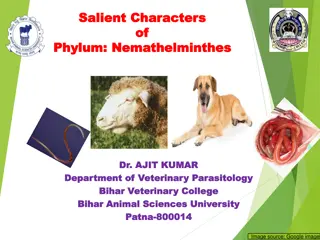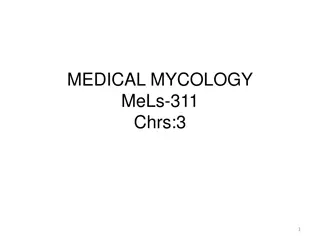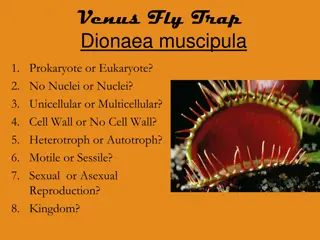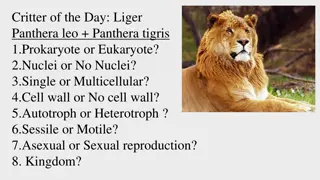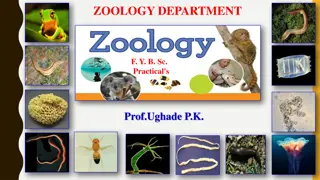Understanding Cell Reproduction and the Cell Cycle
Explore the process of cell reproduction, DNA structure, chromosomes, and the differences between prokaryotic and eukaryotic cell cycles. Learn about binary fission, mitosis, and cytokinesis in the context of cellular growth and division. Understand the significance of genes, DNA organization into c
5 views • 56 slides
CELLS
Discover the incredible world of cells in the human body, each playing a vital role in sustaining life. Explore the diversity of cell types, learn about the history of microscopy, and delve into the Cell Theory. Understand the differences between prokaryotic and eukaryotic cells, essential building
1 views • 69 slides
Understanding Prokaryotic and Eukaryotic Cell Structure
This comprehensive guide explores the structures and characteristics of prokaryotic and eukaryotic cells. Learn about the differences and similarities between these cell types, including features like cell wall composition, membrane-bound organelles, nucleus presence, DNA structure, ribosomes, and m
7 views • 20 slides
Understanding Fungal Microorganisms and Their Impact on Human Health
Fungal microorganisms, including yeast and mold, play crucial roles in the human body's ecosystem. They can be both beneficial and harmful, influencing conditions like candidiasis and mycoses. Learn about the diverse forms and functions of eukaryotic organisms, their morphology, and the transition b
8 views • 33 slides
Understanding Applied Microbiology: Insights into Microbial Diversity and Cell Organization
Applied Microbiology focuses on harnessing the capabilities of microorganisms for the production of beneficial products like medicines, vaccines, and biotechnological advancements. This field explores the intricate interactions between prokaryotic and eukaryotic organisms, emphasizing their pivotal
0 views • 23 slides
Understanding Transcription Factors and Regulatory Sequences in Gene Expression
Transcription factors play a crucial role in gene expression by controlling the recruitment of RNA polymerase. Promoter regions contain sequences like CAAT box and TATA box that regulate transcription by binding proteins. Consensus sequences are conserved patterns in the genome with various biologic
2 views • 10 slides
AP Biology FRQ Practice
Bacterial growth over time and the effects of hypertension on blood vessels are analyzed in this FRQ practice. Factors influencing the growth curve, bacterial advantages in molecular research, and limitations in studying eukaryotic gene expression are explored. Additionally, the interaction of ouaba
1 views • 40 slides
An Overview of Cell Biology: From Cytology to Modern Studies
Cell biology, also known as cytology, explores cells from various perspectives including physiological, developmental, and evolutionary aspects. Modern Cell Biology delves into the mechanisms of metabolism, heredity, and evolution at the molecular level, involving proteins, RNAs, and DNA. The compar
0 views • 13 slides
Understanding the Construction of cDNA Library by Kamal Kumar Gupta
cDNA library construction involves isolating mRNA, converting it to cDNA using reverse transcriptase, and synthesizing a complementary DNA strand. The resulting library is enriched with actively transcribed gene fragments, making it valuable for eukaryotic gene analysis. However, cDNA libraries lack
0 views • 14 slides
Overview of Nemathelminthes: Salient Characters and General Characteristics
Nemathelminthes, a phylum of eukaryotic organisms, include parasites such as helminths. This summary covers the salient characters and general characteristics of Nemathelminthes, focusing on the classes within this phylum, like Nematoda. The description highlights key features like body shape, prese
0 views • 15 slides
An Overview of Medical Mycology: Fungi and Their Characteristics
Medical mycology, focusing on fungi that infect humans, explores the study of fungi, their morphology, classification, and diseases. Fungi, non-photosynthetic organisms, lack chlorophyll and depend on external organic sources for nutrients. With an eukaryotic nature, fungi exhibit less differentiati
0 views • 68 slides
Giant Chromosomes: Lampbrush and Polytene Chromosomes
Giant chromosomes, such as lampbrush and polytene chromosomes, are significantly larger in size compared to normal chromosomes. Lampbrush chromosomes are found in oocytes of various vertebrates, while polytene chromosomes are common in dipteran flies like Drosophila. These specialized chromosomes pl
0 views • 10 slides
Cell Structure and Function: A Comprehensive Overview
Delve into the world of cells, exploring the distinct features of animal and plant cells, the differences between prokaryotic and eukaryotic cells, the significance of organelles, and the fascinating processes such as stem cell differentiation and cell adaptation. Discover how substances move across
0 views • 5 slides
The Fascinating Venus Fly Trap - A Carnivorous Plant
The Venus Fly Trap, scientifically known as Dionaea muscipula, is a unique carnivorous plant found in the southern swamps of the US. It is a eukaryotic, multicellular autotroph that thrives in poor, nutrient-deficient soils by capturing insects for essential nutrients like nitrogen. Its trapping mec
0 views • 12 slides
Amazing Facts About Goliath Bird-Eating Spiders
The Goliath bird-eating spiders, belonging to the Animalia kingdom, are fascinating creatures found in South America. They are eukaryotic, multicellular, heterotrophic, and exhibit sexual reproduction. These spiders have unique features like venomous glands, sensory hairs, and the ability to produce
0 views • 8 slides
The Fascinating World of Ligers: A Unique Hybrid Species
Ligers are captivating hybrid creatures born from the union of lions and tigers. Being eukaryotic, multicellular, heterotrophic, and motile organisms with no cell wall, ligers exhibit intriguing reproductive behaviors and are considered part of the Animalia kingdom. Despite their infertility, the su
4 views • 8 slides
Insights into Bacteria Reproduction and Cell Division
Explore the fascinating world of bacteria reproduction through binary fission, conjugation, and mitosis. Uncover the similarities and unique aspects of prokaryotic and eukaryotic cell division processes. Learn how conjugation plays a vital role in transferring genetic information between bacteria ce
0 views • 21 slides
Posttranscriptional Modification of RNA Overview
A primary transcript is the initial RNA copy of a transcription unit, subject to posttranscriptional modifications like cleavage and further alterations to form functional tRNAs, rRNAs, and mRNAs. In eukaryotic cells, pre-rRNAs and pre-tRNAs undergo processing by ribonucleases to yield mature RNA sp
0 views • 12 slides
Understanding Bacterial Cell Structure and Function
Bacteria display unique cellular structures and functions that differ from eukaryotic cells. They have a simple structure with a plasma membrane but lack complex internal membrane systems. The cytoplasm contains inclusion bodies, ribosomes, and genetic material in the nucleoid. Bacteria can be categ
4 views • 21 slides
Understanding the Molecular Composition of Living Cells
Living cells are primarily composed of hydrogen, oxygen, nitrogen, carbon, phosphorus, and sulfur, which form the basis of organic biomolecules. Cells have common features such as cytoplasm, cell membranes, and nuclei. Different types of cells exist, ranging from eukaryotic with organized nuclei to
0 views • 9 slides
Understanding the Fascinating World of Fungi: Mycology Insights
Explore the realm of fungi through the lens of mycology, delving into their diverse characteristics, including their eukaryotic nature, heterotrophic lifestyle, and impact on various ecosystems. Discover how fungi play crucial roles as saprophytic, symbiotic, or parasitic organisms, influencing food
0 views • 26 slides
Classification and Characteristics of Phylum Protozoa
Phylum Protozoa comprises unicellular, microscopic, eukaryotic organisms found mostly in aquatic habitats. They exhibit diverse locomotory structures such as cilia, flagella, or pseudopodia. These protists may possess a cellulose cell wall and various membrane-bound organelles like mitochondria and
0 views • 21 slides
Exploring the Fascinating Kingdom Protista: Classification and Characteristics
Dive into the diverse world of Kingdom Protista, encompassing a wide range of eukaryotic organisms not classified under animals, plants, or fungi. Discover their classification based on nutrition acquisition and explore animal-like protists, such as zooflagellates, sarcodines, ciliates, and sporozoa
0 views • 21 slides
Understanding Unicellular and Multicellular Organisms in Biology
Explore the basic differences between unicellular and multicellular organisms, including the distinctions between prokaryotes and eukaryotes. Unicellular organisms, such as bacteria and amoeba, consist of a single cell and are often microscopic. Examples of both prokaryotic and eukaryotic unicellula
0 views • 10 slides
Understanding Genes, Chromosomes, Alleles, and Mutations in DNA
Explore the intricate world of genetics through genes, chromosomes, alleles, and mutations. Delve into the fundamental structures of DNA, such as nucleosomes and eukaryotic chromosomes. Gain insights into key genetic terms like genes, alleles, and genome composition. Learn about mutations, including
0 views • 11 slides
An Overview of Genetics and Cellular Components
Explore the fundamental concepts of genetics, including cell types, genetic material, heredity, and genetic terminology. Learn about prokaryotic and eukaryotic cells, chromosomes, DNA, genes, and the study of heredity. Discover the significance of genetic information stored in the nucleus and its ro
0 views • 13 slides
Overview of Cell Division in Prokaryotes and Eukaryotic Cells
Cell division plays a crucial role in the growth and reproduction of all organisms. In prokaryotic cells, binary fission is the primary mode of division, while eukaryotic cells undergo a more complex process involving cell growth, DNA replication, chromosome distribution, and cytokinesis. The cell c
0 views • 10 slides
Understanding Sequence Alignment in Next-Generation Sequencing Data
Sequence alignment plays a crucial role in analyzing Next-Generation Sequencing (NGS) data by identifying similarities between DNA, RNA, or protein sequences. Global and local alignment methods are used to arrange sequences and locate fragments derived from specific genes or transcripts. Challenges
0 views • 31 slides
General Characteristics of Fungi and Mycology Overview
Fungi, diverse eukaryotic organisms, exhibit various characteristics such as heterotrophic nature, distinct cell wall composition, and different modes of reproduction. Mycology, the study of fungi, delves into their classification and functions. Fungal cells may be unicellular or filamentous, with m
0 views • 15 slides
Differences Between DNA Replication and RNA Transcription
This content discusses the general variances between DNA replication and RNA transcription, highlighting their purposes, processes, enzymes involved, timing, and more. It delves into the initiation, template, and involved areas of replication and transcription, as well as key DNA regions like promot
0 views • 24 slides
Investigating Regulation of Aging by Transcription Factors DAF-16 and SKN-1 in the IIS Pathway in C. elegans
Aging regulation in eukaryotic organisms, particularly in Caenorhabditis elegans, is studied through the Insulin/Insulin-like Growth Factor-1 Signaling pathway. This research focuses on understanding how transcription factors DAF-16 and SKN-1 may act together to promote longevity by reducing the IIS
0 views • 11 slides
Understanding DNA Replication and Genetic Transcription
Explore the fundamental concepts of molecular biology focusing on DNA replication, transcription of genetic material into mRNA, and translation into functional proteins. Learn about the semiconservative nature of Eukaryotic DNA replication, the proteins involved, steps in the replication process, an
0 views • 25 slides
Exploring Molecular Biology and Cell Science
Molecular biology delves into the study of biology at the molecular level, focusing on gene structure and functions to comprehend hereditary traits, genetic variation, and gene expression patterns. Cells, the fundamental units of life, vary in shape and function but share basic structures. The Three
0 views • 31 slides
Comparison of Eukaryotic and Prokaryotic Cells in Cell Biology
Cells are the fundamental units of life, but viruses are an exception as they lack cells. Eukaryotic cells have a defined nucleus with a nuclear membrane housing chromosomes, while prokaryotic cells lack a membrane-bound nucleus and other organelles. Eukaryotic cells are larger, containing membrane-
0 views • 9 slides
Cell Division Mechanisms in Prokaryotic and Eukaryotic Cells
Prokaryotic cells divide through binary fission, while eukaryotic cells undergo mitosis with nuclear division and cytokinesis. Prokaryotic cells lack a nucleus and divide by replicating DNA and forming two identical daughter cells. Eukaryotic chromosomes, associated with histone proteins, undergo co
0 views • 56 slides
Cell Observation Lab for Prokaryotic and Eukaryotic Cells
Explore the differences between prokaryotic and eukaryotic cells through a hands-on lab. Observe, sketch, and label organelles in bacteria (yogurt), protists (pond water), fungi (yeast), and plant cells (onion and anacharis). Learn to differentiate cellular structures and understand the characterist
0 views • 17 slides
Prokaryotic and Eukaryotic Cells: A Comparative Overview
Prokaryotic cells are simpler and lack membrane-bound organelles, reproducing through binary fission. Eukaryotic cells are more complex, larger, with a nucleus enclosed in a nuclear envelope. They have various organelles and a cell wall. The plasma membrane defines cell boundaries, regulating the pa
0 views • 13 slides
Understanding Prokaryotic and Eukaryotic Chromosome Organization
Chromosomes are vital structures in cells, holding genetic material. Prokaryotic cells have a nucleoid containing DNA while eukaryotic cells have DNA enclosed in a nucleus. Proteins like H-NS, HU, FIS, and IHF play crucial roles in maintaining chromosome structure and gene expression. Unlike eukaryo
0 views • 20 slides
Understanding Genes and the Genetic Code for Protein Synthesis
Explore the structures of genes, the degeneracy of the genetic code, and the process of protein synthesis through transcription, RNA processing, and translation. Delve into the role of exons, introns, promoters, and operators in gene expression in eukaryotic cells. Learn why the genetic code is dege
0 views • 13 slides
Understanding Gene Structure and Splicing in Eukaryotic Cells
Explore the intricate world of gene structure and splicing in eukaryotic cells, covering topics such as exon-intron organization, central dogma, protein synthesis, genetic codes in translation, and protein 3D structure. Gain insights into the fundamental processes that regulate gene expression and p
0 views • 16 slides









